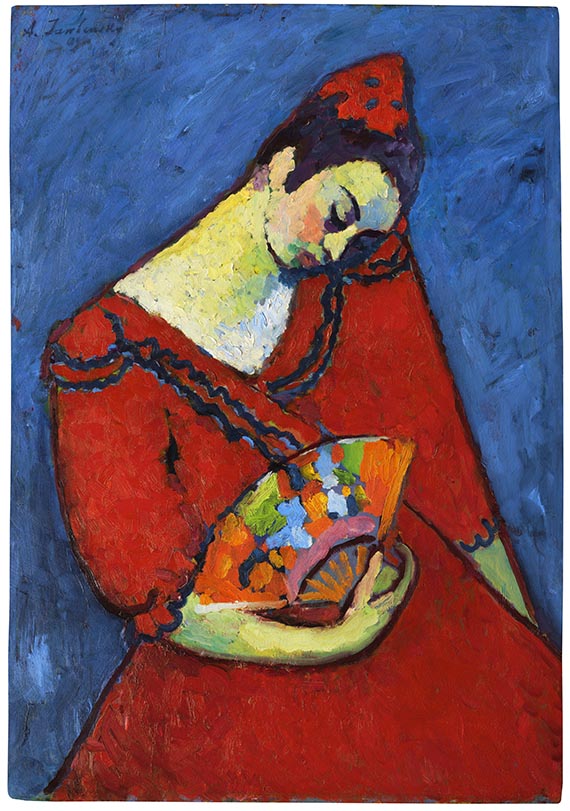Dictionary


New Objective Classicism
New Objective Classicism was the most relevant and largest tendency within New Objectivity. Alternative terms are "Neo-classicist tendency" or "Neo-Romantic Tendency" in New Objectivity. In parts, New Objective Classicism shows notions of Constructivism, however, Expressionism, Cubism and the oeuvre of Paul Cézanne resonate in some early works. Its main representatives were Christian Schad, Wilhelm Schnarrenberger, Alexander Kanoldt, Georg Schrimpf, Carlo Mense, Eberhard Viegener, Rudolf Dischinger and Bernhard Dörries.
Unlike Verism, New Objective Classicism did not have the harsh reality of life as its topic, but tends to a certain idealization. The paintings often wander off into the distance of timeless immobile landscapes, which seem to be located, as it had already been the case with earlier ideal landscapes, in Italy (Georg Schrimpf, Carlo Mense, Carl Hofer). Man is depicted in a still-life like calmness and isolation, existence is regarded as a responsibility devoid of any fate.
Max Ackermann, Volker Böhringer, Heinrich Maria Davringhausen, August Wilhelm Dressler and Anton Räderscheidt prove to be more critical artists of New Objective Classicism, as their works take on the subject of common, simple people. In parts, these artists actual come close to Surrealism.
With some of its works, New Objective Classicism also clearly touches Verism, as it is the case with the Hanover artists (Grethe Jürgens, Gerta Overbeck-Schenck, Ernst Thoms, Erich Wegner et al), which were close to the "Assoziation revolutionärer bildender Künstler" (Associations of Revolutionary Visual Artists, short ASSO), a group that was in close connection with the German Communist Party. Grethe Jürgens` picture "Arbeitslose vor dem Arbeitsamt" (Jobless People in front of the Employment Bureau, 1929) exemplarily illustrates this tendency.
New Objective Classicism was the most relevant and largest tendency within New Objectivity. Alternative terms are "Neo-classicist tendency" or "Neo-Romantic Tendency" in New Objectivity. In parts, New Objective Classicism shows notions of Constructivism, however, Expressionism, Cubism and the oeuvre of Paul Cézanne resonate in some early works. Its main representatives were Christian Schad, Wilhelm Schnarrenberger, Alexander Kanoldt, Georg Schrimpf, Carlo Mense, Eberhard Viegener, Rudolf Dischinger and Bernhard Dörries.
Unlike Verism, New Objective Classicism did not have the harsh reality of life as its topic, but tends to a certain idealization. The paintings often wander off into the distance of timeless immobile landscapes, which seem to be located, as it had already been the case with earlier ideal landscapes, in Italy (Georg Schrimpf, Carlo Mense, Carl Hofer). Man is depicted in a still-life like calmness and isolation, existence is regarded as a responsibility devoid of any fate.
Max Ackermann, Volker Böhringer, Heinrich Maria Davringhausen, August Wilhelm Dressler and Anton Räderscheidt prove to be more critical artists of New Objective Classicism, as their works take on the subject of common, simple people. In parts, these artists actual come close to Surrealism.
With some of its works, New Objective Classicism also clearly touches Verism, as it is the case with the Hanover artists (Grethe Jürgens, Gerta Overbeck-Schenck, Ernst Thoms, Erich Wegner et al), which were close to the "Assoziation revolutionärer bildender Künstler" (Associations of Revolutionary Visual Artists, short ASSO), a group that was in close connection with the German Communist Party. Grethe Jürgens` picture "Arbeitslose vor dem Arbeitsamt" (Jobless People in front of the Employment Bureau, 1929) exemplarily illustrates this tendency.
Offers
Headquarters
Joseph-Wild-Str. 18
81829 Munich
Phone: +49 89 55 244-0
Fax: +49 89 55 244-177
info@kettererkunst.de
Louisa von Saucken / Undine Schleifer
Holstenwall 5
20355 Hamburg
Phone: +49 40 37 49 61-0
Fax: +49 40 37 49 61-66
infohamburg@kettererkunst.de
Dr. Simone Wiechers / Nane Schlage
Fasanenstr. 70
10719 Berlin
Phone: +49 30 88 67 53-63
Fax: +49 30 88 67 56-43
infoberlin@kettererkunst.de
Cordula Lichtenberg
Gertrudenstraße 24-28
50667 Cologne
Phone: +49 221 510 908-15
infokoeln@kettererkunst.de
Hessen
Rhineland-Palatinate
Miriam Heß
Phone: +49 62 21 58 80-038
Fax: +49 62 21 58 80-595
infoheidelberg@kettererkunst.de
We will inform you in time.




